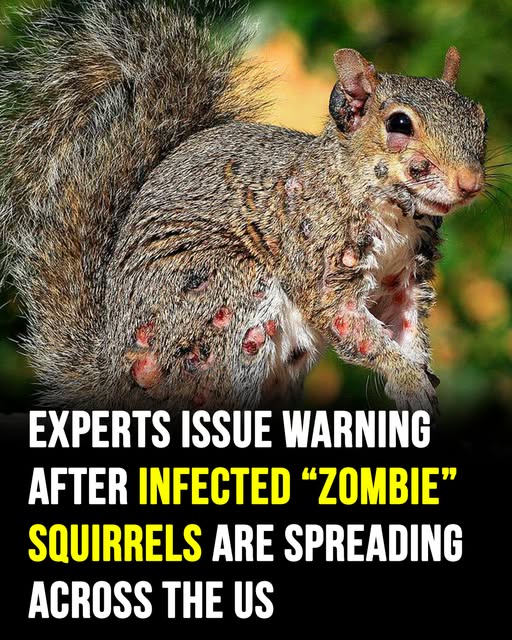In recent weeks, startling images of squirrels with unusual growths on their faces have circulated widely on social media, prompting concern, curiosity, and even a fair bit of fear. Posts on platforms like Reddit and Facebook have shown these small mammals with large facial lumps, sparking questions from users worldwide about what could be causing such odd appearances.
One Reddit user asked, “Any ideas what is going on with this little fella?” after spotting a squirrel with a noticeably swollen face. The images, shared thousands of times, quickly went viral, leading some observers to describe the creatures as “zombie squirrels” due to their eerie, distorted appearance.
What Are “Zombie Squirrels”?
The term “zombie squirrel” is not an official wildlife designation. It is a nickname given by social media users to squirrels affected by a particular condition that can distort their natural features. While the nickname may sound alarming, experts stress that these animals are not undead or supernatural.
Wildlife biologists and veterinarians have identified the condition as squirrel pox, also referred to as squirrel fibromatosis. This naturally occurring viral infection primarily affects the Eastern gray squirrel but can occasionally be seen in other species as well.
Understanding Squirrel Pox
Squirrel pox is a viral disease caused by the Squirrel Fibroma Virus, a member of the poxvirus family. The virus manifests as nodular growths or tumors, usually appearing on the face, limbs, and sometimes the torso of infected squirrels. While the growths may look alarming, the virus is species-specific and does not pose a risk to humans or pets.
According to wildlife biologist Shevenell Webb, the condition is “naturally occurring and will run its course in time.” In most cases, the virus spreads among squirrels through direct contact or environmental exposure, and affected animals may recover once their immune system fights off the infection.
Why Do These Growths Appear?
The visible tumors caused by squirrel pox are a direct result of viral replication in the squirrel’s skin cells. These fibromas can vary in size and shape and are often described as fleshy, wart-like lumps. In some severe cases, the growths can be large enough to distort the animal’s appearance, which explains why social media users have likened them to “zombies.”
Experts note that while these tumors may look grotesque, they are usually benign. The virus does not typically affect internal organs, and most infected squirrels can continue normal activities like eating, climbing, and reproducing, although larger tumors may occasionally impair movement or feeding.
How Common Is Squirrel Pox?
Despite the shock it causes online, squirrel pox is more common than people might think. In areas with high squirrel populations, a small percentage of animals may develop visible tumors at any given time. Many cases go unnoticed because not all infected squirrels develop large or visible growths.
Dr. Webb explained, “It is not rare, but the animals that show extreme growths are the ones that tend to capture human attention. The virus is part of the natural ecology of squirrels, and most affected animals are otherwise healthy.”
Social Media Reactions
The viral images have sparked a mixture of alarm, fascination, and humor online. Many users were initially frightened, posting comments speculating about mysterious diseases or environmental hazards. Others joked about “zombie apocalypses” or shared memes, using humor as a way to process the strange sight of squirrels with facial tumors.
These reactions illustrate how wildlife phenomena can quickly become sensationalized online, even when the underlying cause is a natural and well-understood condition.
Why You Shouldn’t Approach Infected Squirrels
While squirrel pox is harmless to humans, experts caution against handling infected animals. The growths themselves are not dangerous, but wild squirrels can bite or scratch if cornered, and any wild animal can carry bacteria or parasites.
Shevenell Webb advises, “I would not recommend trying to capture a squirrel that has the virus. Observe from a distance and enjoy watching wildlife safely.”
Local wildlife agencies recommend allowing nature to take its course. Intervening in the life of an infected squirrel can cause stress to the animal and could inadvertently spread the virus to other animals if proper precautions are not followed.
How the Virus Spreads
Squirrel pox is transmitted primarily through direct contact with infected squirrels, including mating, fighting, or sharing nesting areas. The virus can also survive temporarily in the environment, meaning that squirrels may be exposed by coming into contact with contaminated surfaces such as tree branches, bird feeders, or communal feeding areas.
Because the disease is species-specific, humans, domestic pets, and other wildlife are not at risk. This specificity also makes squirrel pox a unique example of how certain viruses evolve to affect particular hosts without crossing species barriers.
Ecological Considerations
Squirrel pox is a natural part of woodland and urban ecosystems. While it can cause noticeable facial tumors, it rarely threatens the overall population of squirrels. Predators, disease, and environmental factors have always played a role in regulating wildlife populations, and squirrel pox is one more factor in this complex ecological balance.
Biologists emphasize that the condition is not an indicator of environmental pollution or habitat degradation, as some online speculation has suggested. Rather, it is a naturally occurring virus that has existed for decades.
Human Fascination With Wildlife Anomalies
Why do images like these go viral so quickly? Humans are naturally drawn to anomalies in nature, especially when they evoke strong emotional reactions such as fear, disgust, or curiosity. “Zombie squirrels” fit this pattern perfectly: the familiar is made strange by the unusual tumors, and social media amplifies every reaction.
The viral nature of these posts demonstrates both the power and pitfalls of online wildlife education. While it can spread awareness, it can also lead to misinformation and unnecessary alarm. Experts encourage sharing accurate information alongside viral content to promote understanding rather than fear.
Observing Wildlife Safely
For those curious about squirrels or other urban wildlife, the key is safe observation. Binoculars, zoom cameras, or simply keeping a respectful distance allows people to learn about animals without putting themselves or the creatures at risk.
Feeding squirrels in public parks or residential areas should be approached cautiously, as direct contact can increase the risk of transmitting diseases among wildlife. Maintaining natural behaviors and habitats ensures that both humans and squirrels remain safe.
Other Common Wildlife Viruses
Squirrel pox is one of many naturally occurring viruses that affect wild mammals. While the disease may look alarming, it is similar in principle to other host-specific infections seen in rabbits, birds, and rodents. Understanding these diseases helps wildlife professionals monitor populations and protect ecosystem health.
Public awareness campaigns, wildlife education programs, and responsible observation all contribute to a more informed and safer relationship with urban wildlife.
What to Do if You Spot an Infected Squirrel
- Observe from a Distance: Use binoculars or zoom photography to avoid disturbing the animal.
- Avoid Contact: Never attempt to touch, feed, or capture an infected squirrel.
- Report Concerns to Local Wildlife Agencies: If you notice unusually high numbers of sick animals, local authorities may monitor the population to ensure ecological balance.
- Share Accurate Information: Help dispel myths by sharing scientific explanations alongside photos.
By following these guidelines, people can safely enjoy observing wildlife while respecting the natural processes that govern animal health.
The Takeaway
The “zombie squirrel” phenomenon may look alarming, but it is a harmless, naturally occurring part of the ecosystem. Squirrel pox, while visually dramatic in some cases, does not pose a threat to humans or pets. The condition reminds us of the complexity and resilience of wildlife populations and highlights how curiosity and social media can intersect with science in surprising ways.
Ultimately, the viral photos serve as an opportunity for education, encouraging observers to learn more about urban ecology, viral diseases in wildlife, and the importance of safe and respectful interaction with nature. By approaching these animals with care and understanding, we can appreciate the fascinating, sometimes bizarre, realities of the natural world without fear.



